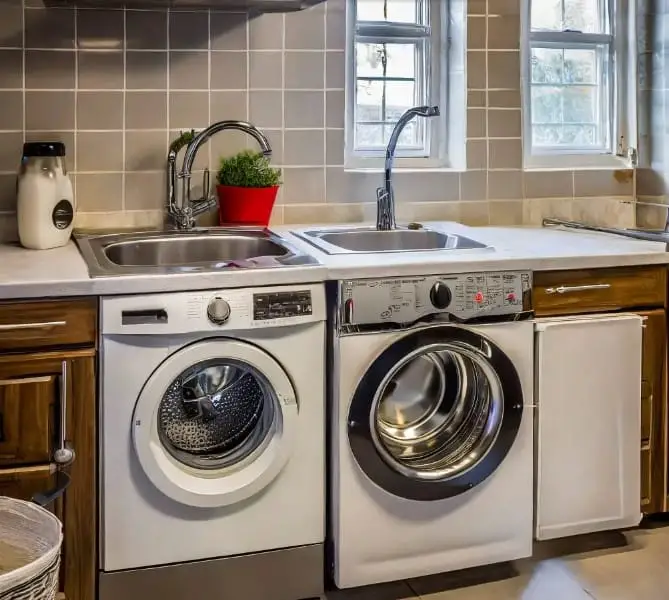To connect a washer and sink to the same drain, you need to install a drain pipe with a Y-fitting and connect the sink’s drain pipe to one end, and the washer’s drain hose to the other end. Add a P-trap to prevent sewer gases from entering the house and secure all connections with hose clamps or pipe fittings.
Ensure proper slope and venting for the drain pipe to achieve optimal drainage.
Plumbing Basics For Dual Drainage
The plumbing system in your home plays a crucial role in ensuring proper drainage and maintaining a healthy living environment. Understanding how your plumbing system works is essential, especially when it comes to dual drainage for your washer and sink.
Your home’s plumbing system consists of various key components that work together to eliminate wastewater and provide a continuous supply of clean water.
| Key Components | Function |
| Drain Pipes | Carry wastewater away from your sink and washer |
| Traps | Prevent sewer gases from entering your home |
| Vent Pipes | Allow air to enter the system and facilitate smooth drainage |
| P-Trap | Collects debris and prevents it from clogging the drain |
| Drainage Standpipe | Connects your washer to the plumbing system |
When installing a washer and sink on the same drain, it is crucial to ensure proper venting, sufficient pipe diameter, and correct installation of the drainage standpipe. Failure to address these aspects may lead to poor drainage, clogs, and unpleasant odors in your home.
Consulting a professional plumber or following local plumbing codes and guidelines can help you ensure a successful dual drainage system for your washer and sink.
Washer And Sink Drain Connectivity
The idea of connecting a washer and sink drain is gaining popularity due to its cost and space-saving benefits. Dual drainage is a simple solution to accommodate both appliances in one drain system.
This connectivity works by combining the outlets of the washer and sink and connecting them to a single drainpipe. By doing so, you can eliminate the need for additional plumbing and reduce installation costs.
One major benefit of a shared drain system is efficient water usage. The water from the sink can be reused for the washer, saving both water and energy. Additionally, combining drainpipes can reduce the overall number of pipes in your home, freeing up valuable space.
However, before implementing dual drainage, consider the capacity and compatibility of your washer and sink. Ensure that the combined flow rate and drain capacity can handle both appliances simultaneously to prevent any potential blockages.
In conclusion, connecting a washer and sink drain can offer numerous advantages, such as cost and space savings, as well as efficient water usage. By carefully planning and ensuring compatibility, you can successfully integrate both appliances into one drain system.
Washer And Sink On Same Drain: Setting Up
Before you begin connecting your washer and sink to the same drain, it is important to gather the necessary tools and materials. You will need:
- Adjustable wrench
- Plumbing tape
- Drain pipe
- Hose clamps
- P-trap
Follow these steps to successfully connect your washer and sink to the same drain:
- Turn off the water supply to both the washer and sink.
- Use the adjustable wrench to disconnect the existing drain pipe from the sink’s drain outlet.
- Apply plumbing tape to the threaded end of the drain pipe.
- Connect the washer’s drain hose to the threaded end of the drain pipe using hose clamps.
- Attach the P-trap to the other end of the drain pipe to prevent sewer gas from entering the room.
- Reconnect the drain pipe to the sink’s drain outlet and tighten it using the adjustable wrench.
- Turn on the water supply and run a test cycle to ensure proper drainage.
Decoding Drainage Regulations
Building codes and regulations for drainage systems play a crucial role in ensuring the proper functioning of a washer and sink on the same drain. It is essential to understand and comply with these local plumbing standards to avoid any potential issues.
When it comes to building codes, each jurisdiction may have its specific requirements. These regulations are in place to maintain the safety and efficiency of drainage systems.
| Key Considerations: | Importance: |
|---|---|
| Capacity of the Drainage System | Ensures effective removal of water and waste. |
| Ventilation | Prevents the buildup of odor, gas, and pressure, maintaining the system’s integrity. |
| Proper Slope | Facilitates the smooth flow of wastewater towards the main sewer line. |
| Traps and Cleanouts | Enable easy access for maintenance and prevent sewer gases from entering the building. |
Before installing a washer and sink on the same drain, it is crucial to consult a professional plumber familiar with local building codes. They can assess the feasibility of the project and ensure proper compliance with the regulations. Adhering to these guidelines guarantees a functional and safe drainage system, preventing any potential issues in the future.
Designing The Drain System
When installing a washer and sink on the same drain, proper planning is crucial for a hassle-free drainage system. Start by evaluating the space and layout considerations of your laundry room or utility area. Measure the available space to determine the best location for the drain pipe. Take into account any existing plumbing lines and obstructions that may affect the drain system’s design.
Once you have assessed the space, create a plan for the drainage system. Consider the following factors:
- Calculate the flow rate and capacity requirements based on the size and usage of the washer and sink.
- Select the appropriate drain pipe size and material to ensure efficient drainage.
- Position the drain pipe at a downward slope to allow smooth flow and prevent clogging.
- Install a trap and vent to prevent sewer gases from entering the room and to maintain proper air pressure.
- Ensure proper venting and connection to the main sewer line to prevent backflow and sewer odor issues.
By carefully considering these factors and designing a well-thought-out drain system, you can effectively manage the drainage needs of both the washer and sink in your home or commercial space.
Avoiding Common Installation Mistakes
When it comes to installing a washer and sink on the same drain, it’s important to avoid common installation mistakes. One of the typical pitfalls in a dual-drain setup is improper pipe sizing. Make sure to accurately measure the drain pipe sizes for both the washer and sink to ensure proper flow. Additionally, failure to install a proper P-trap can lead to sewer gas odors and potential health hazards. Ensure that a P-trap is installed correctly to prevent these issues.
Another common mistake is using incorrect fittings. It’s crucial to use the right fittings and connectors to ensure a secure and leak-free connection. Moreover, inadequate venting can also cause problems in a dual-drain setup. Proper venting is essential to allow air to escape and prevent clogs or slow drains.
| Tip | Description |
|---|---|
| 1. | Ensure proper pipe sizing for both the washer and sink drains. |
| 2. | Install a P-trap correctly to prevent sewer gas odors. |
| 3. | Use the right fittings and connectors for secure connections. |
| 4. | Properly vent the dual drain setup to prevent clogs or slow drains. |
By avoiding these installation mistakes and following these tips, you can ensure a smooth and efficient dual-drain setup for your washer and sink.
Maintaining Your Dual Drain System
Maintaining a dual drain system with a washer and sink on the same drain can help prevent issues and prolong the life of your plumbing. Routine maintenance is key to ensuring everything operates smoothly. Keep an eye out for potential problems to catch them early. Regularly check for any leaks or drips around the plumbing connections, as these can indicate loose fittings or worn-out seals. Clean the drain pipes on a regular basis to prevent clogs from building up. Using a plunger or drain snake can help remove any obstructions. It’s also important to be mindful of what you put down the drains, avoiding grease, hair, and other debris that can contribute to blockages. By following these maintenance tips, you can keep your dual-drain system in good working order for years to come.
Enhancing Drainage Efficiency
When your washer and sink share the same drain, it is crucial to ensure efficient water flow. To achieve this, several recommendations can be followed:
- Install a larger drain pipe: Upgrading to a larger drain pipe allows for better water flow, reducing the risk of clogs and backups.
- Use a separate vent pipe: By installing a dedicated vent pipe for the washer and sink drain, you can prevent air pressure imbalances and optimize drainage performance.
- Install a backwater valve: A backwater valve prevents wastewater from flowing back into the plumbing system, improving overall drainage efficiency.
- Regular maintenance: Periodic pipe cleanings and inspections can help identify potential issues before they become major problems, ensuring the smooth flow of water.
- Consider a professional consultation: Consulting an expert plumber can provide valuable insights tailored to your specific needs, ensuring the most efficient washer and sink drain system.
By implementing these upgrades and following these recommendations, you can enhance the efficiency of your washer and sink drain system, minimizing the risk of drainage issues and maintaining optimal water flow.
Frequently Asked Questions For Washer And Sink On Same Drain: How To?
Can A Washing Machine And Sink Share The Same Drain?
Yes, a washing machine and sink can share the same drain. It is common for both the washing machine and sinks to connect to the same main drainpipe for efficient plumbing. This setup allows for proper drainage and prevents any overflow or clogging issues.
How Do I Connect Two Appliances To One Waste Pipe?
To connect two appliances to one waste pipe, use a T-joint or Y-joint plumbing fitting. Connect the waste pipes from both appliances to the joint using the appropriate connectors or adapters. Ensure tight connections and proper alignment for effective drainage.
Can I Add A Sink To My Washer Drain?
Yes, you can add a sink to your washer drain. Make sure to hire a professional plumber to ensure proper installation and prevent any potential drainage issues.
Why Does My Washer Drain Into My Sink?
Your washer drains into the sink to prevent water from overflowing and causing a mess. This setup helps to manage the excess water efficiently.
Conclusion
To sum up, combining your washer and sink drain is a practical and efficient solution for optimizing space and simplifying plumbing. By following the step-by-step guide outlined in this blog post, you can successfully connect your appliances to a single drain system.
Remember to ensure proper ventilation and consult a professional if needed. Now you can enjoy a more streamlined and organized laundry area while maximizing the functionality of your space.

